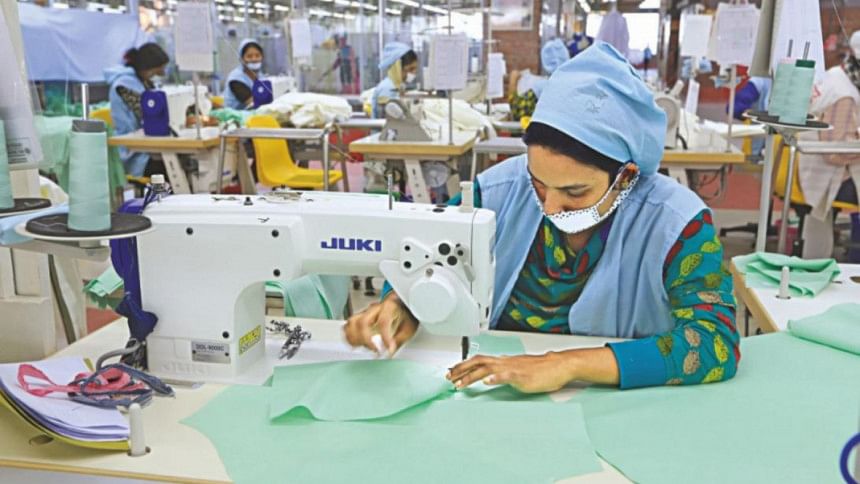It is our ‘competitiveness‘ which is holding us back

There are two contrasting contexts as far as the competitiveness of Bangladesh economy is concerned. On the one hand, the economic growth rate in Bangladesh has been increasing since 2013; it increased from 6 percent in that year to a staggering 7.9 percent in 2018. On the other hand, during the same period, according to the Global Competitiveness Index (GCI), out of 152 countries, the ranking of Bangladesh slipped from 99 to 118 and the GCI value saw a secular decline from 3.91 to 3.65. Does this mean that competitiveness is not an issue as far as accelerating economic growth in Bangladesh is concerned?
According to the World Economic Forum, the GCI is a set of institutions, policies and factors that determine the level of productivity of a country. The GCI 2019 identifies 12 major areas which are used to construct the aggregate GCI. These are Institutions, Infrastructure, Macroeconomic Environment, Health and Education, Higher Education and Training, Goods Market Efficiency, Labour Market Efficiency, Financial Sector Development, Technological Readiness, Market Size, Business Sophistication, and Innovation. In most of these areas, Bangladesh's scores are very poor. In comparison to Bangladesh's major competitors in the global market, like China, India and Vietnam, Bangladesh is significantly lagging behind them in all the GCI areas except the Macroeconomic Environment.
Given the current global and domestic economic scenarios, it is hard to believe that competitiveness is not an issue for further accelerating and sustaining economic growth in Bangladesh. The country is expected to graduate from the Least Developed Country (LDC) status by 2024. This will lead to several challenges for the country's export sector due to the loss of preference in its major export destinations. The country expects to achieve the stringent SDGs by 2030 and also eyes to become an upper middle-income country by 2031 and a high-income country by 2041. There are also changing global trade scenarios. The ongoing trade war between the USA and China, the Brexit, the collapse of the multilateral trade negotiations under the WTO, growing protectionism in the developed countries, China's Belt and Road Initiative (BRI), and the emergence of mega-trading blocs are examples of the changing global trade scenarios.
On the domestic front, the country's economic growth prospect is closely linked to the growth in exports, remittances, and private-sector investment. However, there have been a slowdown in growth in exports and remittances over the past few years. Also, sluggish private-sector investment over the past few years remains a big concern. All these have been accompanied by the falling trend in export-GDP, remittance-GDP and FDI-GDP ratios in recent years. Moreover, the export basket of the country persists to be highly concentrated around the RMG, and the diversification efforts over the past few decades have not seen much success. Even if we look at the RMG exports of Bangladesh, which now occupy around 84 percent of the total exports, the RMG export basket is also highly concentrated. At the 6-digit HS code level, only 10 RMG products account for 68 percent of the total RMG exports. The corresponding figures for China, India and Vietnam are 36 percent, 46 percent and 42 percent, respectively.
The scenario of the inflow of foreign direct investment (FDI) in Bangladesh is frustrating. The FDI share in GDP in 2018 in Bangladesh was even lower than the LDC average. During 2014 and 2018, on average, Bangladesh's FDI-GDP ratio was 1.2 percent and Bangladesh attracted USD 2.5 billion FDI annually. By contrast, during the same period, the average FDI-GDP ratio of Vietnam was 6 percent and the annual average FDI inflow was USD 12.6 billion.
The upshot of the above discussion points to the fact that there is a need for significantly enhancing the competitiveness of our economy in the coming years to address the aforementioned challenges and meeting the development goals. There are two types of competitiveness: price and non-price competitiveness. While price competitiveness is dependent on labour costs, relative inflation and real effective exchange rate (REER), the non-price competitiveness is dependent on a number of issues including product quality and design, business research and development (R&D), strength of "local" brands, effectiveness of marketing in overseas markets, levels of dynamic efficiency of firms, levels of "x" inefficiency (poor management, excessive bureaucracy, government failures), and investment in human capital (for skill development). There is no denying the fact that while in terms of labour costs, Bangladesh has a competitive advantage over many of its competitors, in the case of other components of price competitiveness and most of the components of non-price competitiveness, Bangladesh is seriously lagging behind its major competitors.
The economy is now witnessing a gradual appreciation of the real effective exchange rate, which is eroding the competitiveness of Bangladesh's exports. Low average years of schooling and very low public expenditure on both education and health as percentages of GDP are resulting in stagnation in skill development and skill diversification. There is a need to undertake reform in critical economic domains including the financial sector, taxation sector, trade and exchange rate policies, and business environment. Faster and cost-effective implementation of the mega projects and special economic zones, attracting large-scale FDI, addressing institutional challenges in export diversification, substantial spending on research and development, and making "skill development and skill diversification" a national priority are the steps towards enhancing the country's competitiveness. There is no doubt that we also need to come out of the so-called comfort zone created by the glossy picture of an ever-increasing GDP growth rate.
Dr Selim Raihan is Professor, Department of Economics, University of Dhaka, Bangladesh, and Executive Director, South Asian Network on Economic Modeling (SANEM). Email: [email protected]

 For all latest news, follow The Daily Star's Google News channel.
For all latest news, follow The Daily Star's Google News channel. 



Comments